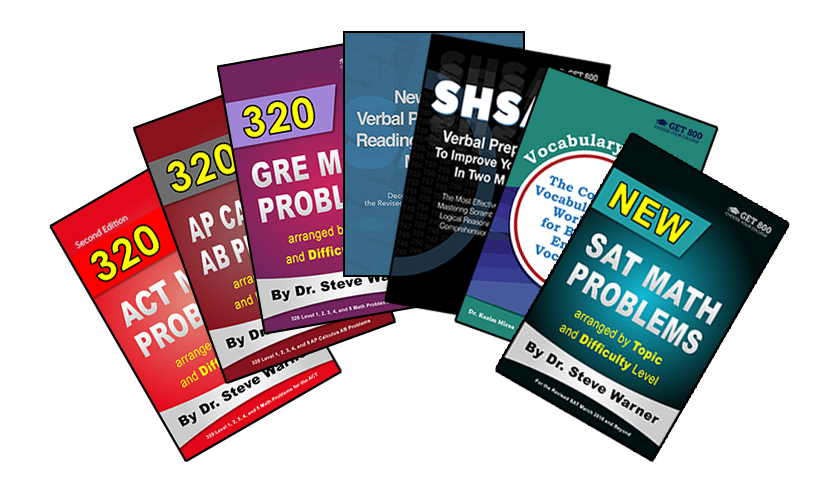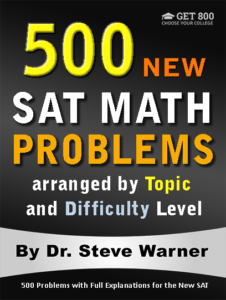
500 New SAT Math Problems
Just 19.99 on Amazon
Hi everyone! The latest edition of 500 New SAT Math Problems is now available in paperback from Amazon. This edition just has been modified from the previous edition to account for the changes on the Digital SAT.
The paperback is now on sale on Amazon for only $19.99. Note that once the sale ends (by the end of today), the price of this book will go up to $42.99.
The promotion has ended. Thanks to everyone who participated. The book is now available at its regular price here: 500 New SAT Math Problems
If you have any questions, feel free to contact me at steve@SATPrepGet800.com
Thank you all for your continued support!
A Trick For Free Two Day Shipping
I would like to finish this post with a little trick you can use to get free 2 day shipping on any of the books you decide to purchase without making any additional purchases. If you have never used Amazon Prime you can sign up for a free month using the following link.
Sign Up For Amazon Prime For Free
If you have already had a free trial of Amazon Prime you can simply open up a new Amazon account to get a new free trial. It just takes a few minutes! You will need to use a different email address than the one you usually use.
This next part is very important! After you finish your transaction, go to your Account, select “Manage my prime membership,” and turn off the recurring billing. This way in a month’s time Amazon will not start charging you for the service.
After shutting off the recurring billing you will still continue to receive the benefit of free 2 day shipping for one month. This means that as long as you use this new Amazon account for your purchases you can do all of your shopping on Amazon for the next month without having to worry about placing minimum orders to get free shipping.
Just be aware that certain products from outside sellers do not always qualify for free shipping, so please always check over your bill carefully before you check out.
Well I hope you decide to take advantage of this very special offer, or at the very least I hope you will benefit from my Amazon “free 2 day shipping trick.” Here is the link one more time:
Sign Up For Amazon Prime For Free
If you think your friends might be interested in this special offer, please share it with them on Facebook:
Thank you all for your continued support!
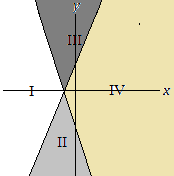
Hard SAT and ACT Math Problem
System of Inequalities
Today I would like to give a hard math problem involving a system of inequalities. This type of question can show up on both the SAT and ACT. I will provide a full explanation for this problem tomorrow. In the meantime, feel free to leave your own solutions in the comments.
Level 5 System of Inequalities
y ≤ 2x + 2
y ≥ –3x – 3
A system of inequalities and a graph are shown above (the graph is at the top of the post). Which section or sections of the graph could represent all of the solutions to the system?
A. Section I
B. Section IV
C. Sections II and III
D. Sections II and IV
E. Sections I, II and IV
More SAT and ACT Math Problems with Explanations
If you are preparing for the SAT or ACT, you may want to take a look at the Get 800 collection of test prep books.
And if you liked this article, please share it with your Facebook friends:
Fun Math T-shirts
Hello everyone. Today I just want to share with you some of my favorite math related t-shirts. Check out my t-shirt collection by clicking the image above. Here are a couple of my favorites:
Click here to see all my favorite t-shirts
The links in this blog post are affiliate links. If you click on one of these links and decide to make a purchase I will receive a commission on the sale. This does not cost you anything additional. These small commissions help to keep the rest of the content on my blog free, so thank you!
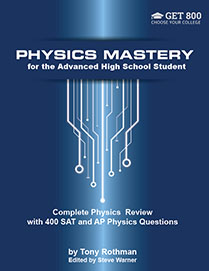 AP Physics Particle Mechanics Problem with Solution
AP Physics Particle Mechanics Problem with Solution

Today I would like to provide a solution to yesterday’s AP Physics Particle Mechanics question. Here is the question one more time, followed by an explanation:
Particle Mechanics Free Response Question with Explanation
Superman is able to leap over tall buildings in a single bound. The tallest building in the world is currently the Burj Khalifa in Dubai, which is about 800 m tall and will soon be overtaken by the Jeddah Tower in Saudia Arabia, which will be 1 km tall. Assuming that Superman’s legs act like springs and that he can bend them 0.5 m, estimate the strength of Krypton’s gravitational acceleration relative to the Earth’s.
Solution: If Superman is able to leap over a building of height h, he must give himself an energy mgeh, where m is his mass and ge is the Earth’s gravitational acceleration. If this energy is to be supplied by the springs in his legs, by energy conservation we must have mgeh = 1/2 kx2, where x is the amount he can bend them and k is his legs’ effective spring constant. On Krypton he must be able to support his own weight by his legs, and so we require by Hooke’s law mgk = kx, where gk is the gravitational acceleration on Krypton. Thus, gk/ge = 2h/x. If h = 1000 m and x = 0 .5 m, then gk/ge = 4000. Krypton is a truly exceptional planet.
More Test Prep Books from Get 800
Check out my product page to see all of the other books from the Get 800 collection: Get 800 Product Page
If you think your friends might be interested in this article, please share it with them on Facebook:
Thank you all for your continued support!
 AP Physics Particle Mechanics Problem
AP Physics Particle Mechanics Problem

In preparation for the release of Physics Mastery for the Advanced High School Student, today I would like to give an AP problem from the book for you to try.
This book was written to help you prepare for the SAT physics subject test, and AP physics 1 and 2 exams. It will be released soon at a special promotional price of about $7.50.
This sale may last for only a few hours, and once the sale ends the price will go up to $34.99. Amazon will automatically raise the price once a predetermined number of copies has been sold. If you want to take advantage of the sale price I strongly recommend that you get on the email notification list.
To be added to the notification list, simply send an email to steve@SATPrepGet800.com with “Notify me” written in the subject line.
And now here is an AP level free response question for you to try. I will post a full solution tomorrow.
Particle Mechanics Free Response Question
Superman is able to leap over tall buildings in a single bound. The tallest building in the world is currently the Burj Khalifa in Dubai, which is about 800 m tall and will soon be overtaken by the Jeddah Tower in Saudia Arabia, which will be 1 km tall. Assuming that Superman’s legs act like springs and that he can bend them 0.5 m, estimate the strength of Krypton’s gravitational acceleration relative to the Earth’s.
More Test Prep Books from Get 800
While you’re waiting for this book to be released, check out my product page to see all of the other books from the Get 800 collection: Get 800 Product Page
If you think your friends might be interested in this article, please share it with them on Facebook:
Thank you all for your continued support!
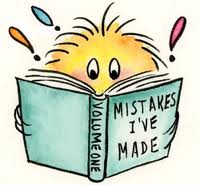 More On Careless Mistakes & Efficient Prepping
More On Careless Mistakes & Efficient Prepping

This post is based upon a question I was asked by a student in regards to being able to increase one’s math score by the next SAT.
In the same question the student states that most of his errors are just “careless” mistakes. I redirected him to my article on avoiding careless mistakes, but let me just repost our conversation here as it has information relevant to a lot of other students. I hope you find this useful…
Student: Hi Dr. Steve, I feel as if I have hit a plateau because I can’t really score higher than a 710. I always do practice sections from the College Board Blue Book and miss around 1-2 questions per section. The questions I get incorrect are usually medium questions and not hard. I believe I make careless mistakes… What should I do? I also tend to do A LOT of practice sections. Could this negatively affect my score? I would like to score 750+ (preferably an 800). Is increasing from a 700 to 750+ in just weeks impractical?
Dr Steve: The increase you are looking for is definitely possible. It sounds like all of your prep right now consists of doing practice tests from the College Board’s Blue Book. You should stop this and start prepping in a more efficient way. Now I also need to know what you mean by the word “usually” when you say that you usually get medium questions incorrect. Does that mean on any given practice test you get more medium questions wrong, or that you practically never get hard questions wrong at all? This distinction is important. Let me start with a few suggestions to get you on the right path.
- If you haven’t done so already, read my article on avoiding careless errors here.
- Go back through all the practice tests you took and start posting up the questions you got wrong here on my Facebook wall. Also explain what the error you made was, no matter how silly or careless you think the errors were. We can then discuss several different ways to solve these problems and how to avoid these errors in the future.
- Are you proficient in the really basic strategies such as plugging in answer choices, picking numbers, taking guesses, etc. If not, then you need to start practicing lots of problems using these strategies even if you know more efficient ways to solve them. The Intermediate Course from my “28 New SAT Math Lessons” series emphasizes these strategies in a systematic way. The Advanced Course reviews these strategies very quickly in the first lesson, but still gives solutions using these techniques throughout the book. In your case, if you did decide to get one of these, I would probably recommend the Advanced, but make sure you are practicing solving as many of these problems as you can using both basic and advanced strategies. If you choose to continue using only the materials you already have, then again, make sure you are practicing both basic and advanced techniques.
- Let me emphasize that as you practice solving SAT math questions, try to solve each one in 2 to 4 ways. Possibly using a basic strategy, a more advanced strategy, the way you would do it in school, and/or the quickest way you can think of. Remember – you will never see any specific math problem that you do on your SAT – it’s more important to learn techniques than it is to solve a specific problem.
- To really improve your score do every problem you get wrong about once per week until you get that question right on your own without making any “careless” errors. Make sure you wait at least several days before reattempting a problem you have gotten wrong. You don’t want to get it right because you recall the mistake you made. You want to get it right because you are no longer falling into the trap you previously fell for.
Student: Well I can confidently say that I know most, if not all, of your strategies (I bought your book and went through the level 5 questions of your book since I got all level 4 questions correct) and that I know all the math involved in most, if not all problems. Out of all the sections I have ever taken, I have only been totally clueless in only like 2 problems. By “usually” I mean I practically never get a hard question wrong unless I make a silly mistake or get tricked, which is quite rare. Since I know not to follow my intuition on hard questions, I tend to check over my work like 2-3 times. On medium questions, however, I tend to work really fast through them. The reason I do this is because it can sometimes take me quite a while to solve some hard questions even if I’m using strategies. Another thing, the way I attack the SAT math section is by just going once through the whole section. Even if I feel that I got all the answers right, I somehow made a mistake in one without noticing. I have question: What is the maximum amount of questions I can miss and still get a 750 or higher? Or does that change from test to test?
Oh wow, I looked back to a problem that I was totally clueless on and solved it in less than 30 seconds.
Dr Steve: To guarantee a 750 you can only get 2 questions wrong. However, the scaling at the high end is very inconsistent, so this varies from test to test.
Based upon your last response, here are a few suggestions:
- For at least the next week focus on one problem at a time (no full practice tests). Go back and pick out problems that have taken you more than 1 minute. Really take the time to work out the problem several different ways and try to really internalize these methods. Then pay special attention to the one that was quickest.
- In about a week take another practice test and really focus on NOT RUSHING. Pace yourself correctly meaning if you are working on a problem for about 30 seconds and you’re still confused by it, mark it off and move on – come back to it later – don’t worry – you’ll get to it, and as long as you’re pacing yourself correctly you will have plenty of time to finish the section, go back and work on the ones you skipped, and you may even have several minutes to go back and redo many of the problems one more time. You may want to read this article.”
The student replied that he would look at the additional material.
I wish him and all other students taking the SAT the best of luck in achieving an exceptional math score.
If you are preparing for the SAT, you may want to check out this special deal on all 8 of my SAT math prep books:
Get Eight Books for the Price of Three
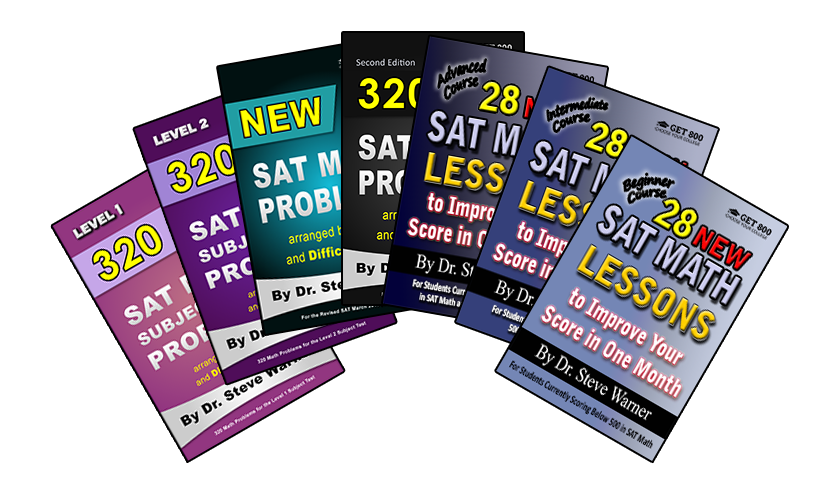
If you think your friends might be interested in the information presented here, please share this post with them on Facebook:
Thank you all for your continued support!
 Physics Mastery – Coming Soon
Physics Mastery – Coming Soon

Today I would like to announce a new prep book for the SAT physics subject test and the AP physics 1 and 2 exams: Physics Mastery for the Advanced High School Student
This book will be released in about two weeks at a special promotional price of about $7.50.
This sale may last for only a few hours, and once the sale ends the price will go up to $34.99. Amazon will automatically raise the price once a predetermined number of copies has been sold. If you want to take advantage of the sale price I strongly recommend that you get on the email notification list.
To be added to the notification list, simply send an email to steve@SATPrepGet800.com with “Notify me” written in the subject line.
In the meantime, you can take a look at my product page to see all of the other books from the Get 800 collection: Get 800 Product Page
If you think your friends might be interested in being notified of this special offer, please share it with them on Facebook:
Thank you all for your continued support!
Get 800 YouTube Channel Videos
Don’t forget to subscribe to the Get 800 YouTube channel.
On my channel you can find lots of SAT and ACT math prep videos, including solutions to College Board questions, and special promotions.
Here are just a few of the videos you can find on my YouTube channel.
I hope you find all of my videos useful. I would really appreciate if you would ‘like’ each of the videos, share them, and make comments. Of course, please subscribe to the channel as well.
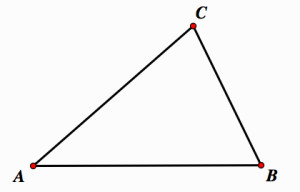
More On The Triangle Rule
Yesterday we discussed the triangle rule, and I provided a few problems from standardized tests where the triangle rule was extremely useful. and it was not hard to see how this simple rule should be applied.
Recall that the triangle rule states that that the length of the third side of a triangle is between the sum and difference of the lengths of the other two sides.
This can be written symbolically as “difference < x < sum” where x is the third side of the triangle.
Today let us look at another type of problem that the triangle rule should be used to solve.
Problems involving distances between three points can often be solved using the triangle rule. After all, when you plot three points and look at the distances between each pair of points, you are looking at the lengths of the sides of a triangle.
Try plotting three points on a piece of paper and you you will immediately see what I mean.
There is a small catch however – sometimes when you plot three points, the points can be collinear: that is they all lie on the same line.
This means that the symbol “<” in the triangle rule should be replaced by the symbol “≤.”
In other words, this time we write “difference ≤ x ≤ sum.”
Let’s look at an example that could appear on a standardized math test.
Points Q, R and S lie in a plane. If the distance between Q and R is 18 and the distance between R and S is 11, which of the following could be the distance between Q and S?
II. 28
III. 29
A) I only
B) II only
C) III only
D) I and III
E) I, II and III
Solution: Okay, to solve this problem, of course we are going to use the triangle rule… In this case, if Q, R and S form a triangle, then the length of QS is between 18 – 11 = 7 and also 18 + 11 = 29. The extreme cases 7 and 29 form straight lines. In this problem that is fine, so the distance between Q and S is between 7 and 29, inclusive. Thus, the answer is choice (E).
You can see how quickly this problem can be solved when the triangle rule is used.
If you want more practice, then please check out the Get 800 collection of test prep books. These have more examples of problems that need to use this rule for efficient and correct answering.
And if you liked this article, please share it with your Facebook friends:

The Triangle Rule
I consider using the triangle rule to be an advanced math strategy for standardized tests. It generally comes up on level 4 and 5 problems on the SAT, ACT and GRE, and the only reason so many students get these problems wrong is because they have never been taught the rule in school.
The triangle rule states that that the length of the third side of a triangle is between the sum and difference of the lengths of the other two sides.
So, for example, if we knew that a triangle had two sides of lengths 5 and 7, respectively, then we could find the possible lengths of the third side by using the triangle rule. Simply note that the sum is
7 + 5 = 12
and the difference is
7 – 5 = 2.
Therefore, the the length of third side lies between 2 and 12.
Let’s get our heads around this with another short example:
Example 1
If a triangle has sides of lengths 2, 5, and x, then we have that
5 – 2 < x < 5 + 2.
That is,
3 < x < 7.
The triangle rule is a very easy concept to understand. Again, the only reason why these are considered tough problems is because the rule is not emphasized in school, and sometimes not taught at all.
So let’s really get this rule into practice by solving some problems that might actually appear on a standardized test.
Example 2
The lengths of the sides of a triangle are x, 8, and 15, where x is the shortest side. If the triangle is not isosceles, what is a possible value of x?
Solution: The triangle rule tells us that
15 – 8 < x < 15 + 8.
That is,
7 < x < 23.
Since x is the shortest side, x < 8. So we must choose a number between 7 and 8. If this were a grid in problem (such as on the SAT or GRE), we could grid in 7.1 or any other decimal or improper fraction between 7 and 8. But inputting 7 or 8 as the answer would be incorrect as these integers are not between 7 and 8!
Okay, one more. This one is a multiple choice question.
Example 3
If x is an integer greater than 5, how many different triangles are there with sides of length 3, 5 and x?
A) One
B) Two
C) Three
D) Four
E) Five
Solution: The triangle rule tells us that
5 – 3 < x < 5 + 3.
That is,
2 < x < 8.
Since x is an integer greater than 5, x can be 6 or 7. So there are two possibilities, choice B.
My students find these problems very straight forward. I hope you do too. But it can be easy to forget the rule you need to use if you do not practice enough with it. If you want more practice, then please check out the Get 800 collection of test prep books. These have more examples of problems that need to use this rule for efficient and correct answering.
And if you liked this article, please share it with your Facebook friends:
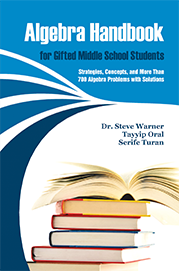 Algebra Handbook for Gifted Middle School Students
Algebra Handbook for Gifted Middle School Students

The Algebra Handbook for Gifted Middle School Students gives you the most effective methods, tips, and strategies for solving algebra problems in both conventional and unconventional ways. The questions presented in this book were created to prepare middle school students for the MATHCOUNTS competition and include many types of number theory, algebra, probability and statistics questions that one can expect to find on the MATHCOUNTS exams.
Click the following link to get to the book’s Amazon page: Algebra Handbook
When you purchase the Algebra Handbook from Amazon, you will also get a free PDF version of 555 Geometry Problems
Take a look at my product page to see all of my books: Get 800 Product Page
A Trick For Free Two Day Shipping
I would like to finish this post with a little trick you can use to get free 2 day shipping on any of the books you decide to purchase without making any additional purchases. If you have never used Amazon Prime you can sign up for a free month using the following link.
Sign Up For Amazon Prime For Free
If you have already had a free trial of Amazon Prime you can simply open up a new Amazon account to get a new free trial. It just takes a few minutes! You will need to use a different email address than the one you usually use.
This next part is very important! After you finish your transaction, go to your Account, select “Manage my prime membership,” and turn off the recurring billing. This way in a month’s time Amazon will not start charging you for the service.
After shutting off the recurring billing you will still continue to receive the benefit of free 2 day shipping for one month. This means that as long as you use this new Amazon account for your purchases you can do all of your shopping on Amazon for the next month without having to worry about placing minimum orders to get free shipping.
Just be aware that certain products from outside sellers do not always qualify for free shipping, so please always check over your bill carefully before you check out.
Well I hope you decide to take advantage of this very special offer, or at the very least I hope you will benefit from my Amazon “free 2 day shipping trick.” Here is the link one more time:
Sign Up For Amazon Prime For Free
Please share this information with your Facebook friends:

